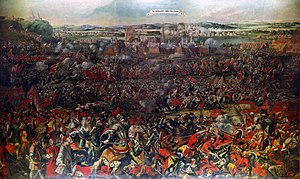 Global Information
Global InformationBattle of Vienna information
| Battle of Vienna | |||||||||
|---|---|---|---|---|---|---|---|---|---|
| Part of the Great Turkish War, the Ottoman–Habsburg wars, and the Polish–Ottoman War | |||||||||
 Battle of Vienna, 12 September 1683 | |||||||||
| |||||||||
| Belligerents | |||||||||
|
Vassal states:
|
Holy League:
| ||||||||
| Commanders and leaders | |||||||||
|
|
| ||||||||
| Strength | |||||||||
|
120,000 soldiers to 65,000 soldiers during 60 days of siege with around 60 guns[3] |
Viennese garrison:
Relief force:
According to Podhorodecki:
Total:
| ||||||||
| Casualties and losses | |||||||||
|
Casualties during the siege: 48,544 killed, 25% desertion and unknown number of deaths from diseases[3] Casualties during the battle: 8,000–20,000[19]: 661 |
Casualties during the siege: 12,000[6] Casualties during the battle: 4,500[19]: 661 3,500 dead or wounded (1,300 Poles)[20] | ||||||||
The Battle of Vienna[a] took place at Kahlenberg Mountain near Vienna on 12 September 1683[2] after the city had been besieged by the Ottoman Empire for two months. The battle was fought by the Holy Roman Empire (led by the Habsburg monarchy) and the Polish–Lithuanian Commonwealth, both under the command of King John III Sobieski, against the Ottomans and their vassal and tributary states. The battle marked the first time the Commonwealth and the Holy Roman Empire had cooperated militarily against the Ottomans. The defeat is often seen as a turning point for Ottoman expansion into Europe, after which they would gain no further ground.[21][Note 3] In the ensuing war that lasted until 1699, the Ottomans would cede most of Ottoman Hungary to Leopold I, Holy Roman Emperor.[21]
The battle was won by the combined forces of the Holy Roman Empire and the Polish–Lithuanian Commonwealth, the latter represented only by the forces of the Crown of the Kingdom of Poland (the march of the Lithuanian army was delayed, and they reached Vienna after it had been relieved).[22] The Viennese garrison was led by Feldzeugmeister of the Imperial Army (Holy Roman Empire) Ernst Rüdiger Graf von Starhemberg, an Austrian subject of Holy Roman Emperor Leopold I. The overall command was held by the senior leader, the king of Poland, John III Sobieski, who led the relief forces.
The opposing military forces were those of the Ottoman Empire and its vassal states, commanded by Grand Vizier Merzifonlu Kara Mustafa Pasha. The Ottoman army numbered approximately 90,000[6] to 300,000[7][8][9][10] men (according to documents on the order of battle found in Kara Mustafa's tent, initial strength at the start of the campaign was 170,000 men[5]). They began the siege on 14 July 1683. Ottoman forces consisted, among other units, of 60 ortas of Janissaries (12,000 men paper-strength) with an observation army of some 70,000[23] men watching the countryside. The decisive battle took place on 12 September, after the arrival of the united relief army.
Some historians maintain that the battle marked a turning point in the Ottoman–Habsburg wars, a 300-year struggle between the Holy Roman and Ottoman Empires. During the 16 years following the battle, the Austrian Habsburgs would gradually conquer southern Hungary and Transylvania, largely clearing them of Ottoman forces. The battle is noted for including the largest known cavalry charge in history.
- ^ a b "Participarea lui Șerban Cantacuzino la cel de-al Doilea Asediul Vienei". Historia (in Romanian). 20 November 2020.
- ^ a b c Finkel, Caroline (2006). Osman's Dream: The Story of the Ottoman Empire, 1300–1923. Basic Books. pp. 286–87. ISBN 978-0-465-02396-7.
- ^ a b c Cite error: The named reference
:2was invoked but never defined (see the help page). - ^ Forst de Battaglia, Otto (1982), Jan Sobieski, Mit Habsburg gegen die Türken, Styria Vlg. Graz, p. 215 of 1983 Polish translated edition
- ^ a b Wimmer, Jan (1983), Wiedeń 1683, MON, p. 306
- ^ a b c d e Bruce Alan Masters, Gábor Ágoston: Encyclopedia of the Ottoman Empire, Infobase Publishing, 2009, ISBN 1438110251, 584.
- ^ a b Harbottle, Thomas (1905), Dictionary of Battles, E.P. Sutton & Co, p. 262
- ^ a b Clare, Israel (1876), The Centennial Universal History: A Clear and Concise History of All Nations, with a Full History of the United States to the Close of the First 100 Years of Our National Independence., J. C. McCurdy & Co., p. 252
- ^ a b Drane, Augusta (1858), The Knights of st. John: with The battle of Lepanto and Siege of Vienna., Burns and Lambert, p. 136
- ^ a b American Architect and Building News. 29.767 (1890): 145. Print.
- ^ a b c Podhorodecki, Leszek (2001), Wiedeń 1683, Bellona, p. 83
- ^ a b c d Şakul, Kahraman (2021). II. Viyana Kuşatması Yedi Ejderin Fendi (in Turkish). İstanbul: Timaş Publishing. pp. 394–395. ISBN 978-6050835663.
- ^ Podhorodecki, Leszek (2001), Wiedeń 1683, Bellona, p. 106
- ^ Podhorodecki, Leszek (2001), Wiedeń 1683, Bellona, p. 105
- ^ Podhorodecki, Leszek (2001), Wiedeń 1683, Bellona, pp. 83, 106
- ^ Tucker, Spencer (2010). Battles That Changed History: An Encyclopedia of World Conflict. ABC-CLIO. p. 215. ISBN 978-1598844290.
- ^ a b Austria's Wars of Emergence, Michael Hochedlinger
- ^ The Enemy at the Gate, Andrew Wheatcroft. 2008.
- ^ a b c Cite error: The named reference
Tuckerwas invoked but never defined (see the help page). - ^ Podhorodecki, Leszek (2001), Wiedeń 1683, Bellona, pp. 140–141
- ^ a b c Leitsch, Walter (July 1983). "1683: The Siege of Vienna". History Today. 33 (7). Retrieved 19 December 2014.
- ^ Davies, Norman (1982), God's Playground, a History of Poland: The Origins to 1795, Columbia University Press, p. 487
- ^ Bruce, George (1981). Harbottle's Dictionary of Battles. Van Nostrand Reinhold.
Cite error: There are <ref group=Note> tags on this page, but the references will not show without a {{reflist|group=Note}} template (see the help page).
Cite error: There are <ref group=lower-alpha> tags or {{efn}} templates on this page, but the references will not show without a {{reflist|group=lower-alpha}} template or {{notelist}} template (see the help page).